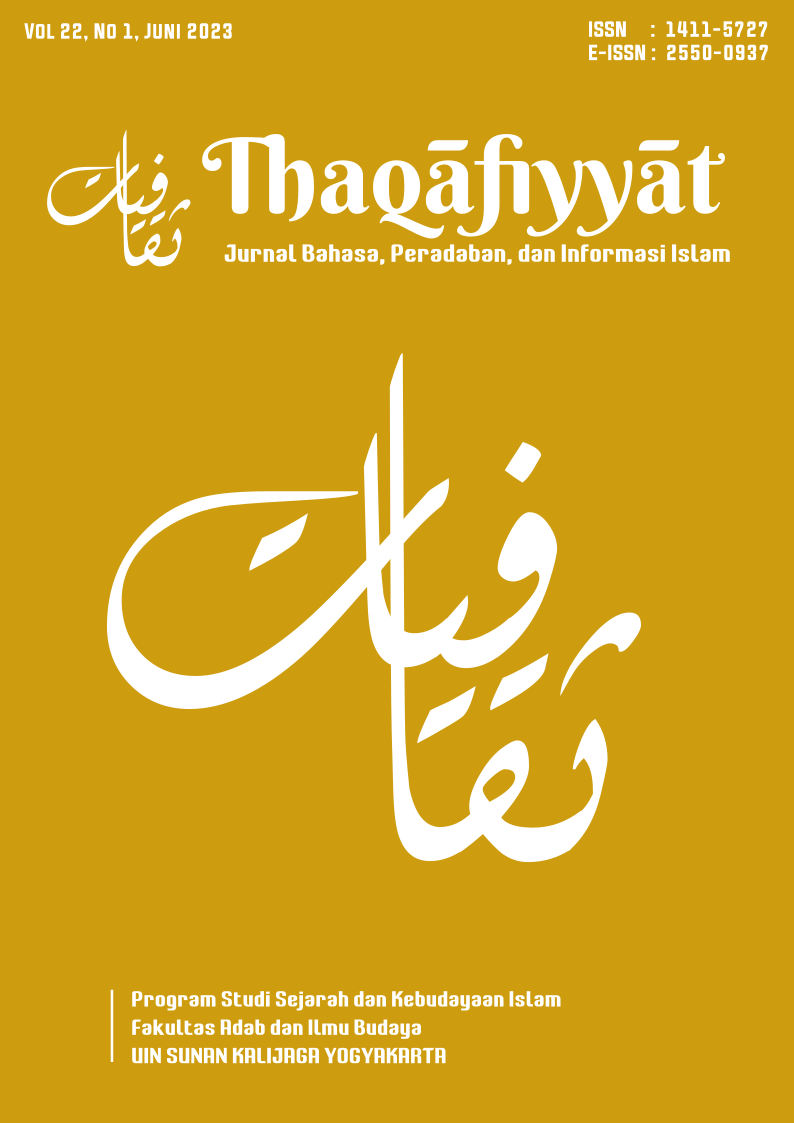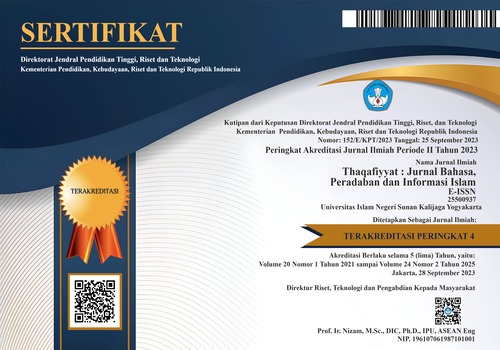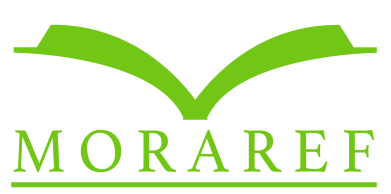Resepsi Al-Qur’an di Pondok Modern Darussalam Gontor Putri 1 Mantingan, Ngawi, Jawa Timur
DOI:
https://doi.org/10.14421/thaq.2022.22104Keywords:
resespi al-Qur’an, Gontor, kaligrafi, estetis, fungsionalAbstract
Abstract: This research is a qualitative study aimed at understanding how the reception of the Quran is actualized in the form of calligraphy, the factors underlying it, the process of creating the calligraphy, and the meaning of the calligraphy for Pondok Modern Darussalam Gontor Putri 1. The analytical method used in this research is descriptive-analytical research, which describes the main issues comprehensively and then analyzes them in detail, thus obtaining a deep understanding of the reception of the Quran in the form of calligraphy at Pondok Modern Darussalam Gontor Putri 1, Mantingan, Ngawi, East Java. The results of this research indicate that Quranic calligraphy is one form of the reception of the Quran. There are several Quranic verses that form the basis of Gontor's education, and some verses are personally selected by the first guardian of Gontor Putri 1, Ust. Ahmad Hidayatullah Zarkasyi. From the calligraphy, two types of receptions are found at Pondok Pesantren Gontor Putri 1: 1) Aesthetic Reception, where the Quran is accepted by female students and teachers of the school in the form of beauty and made the main decoration of the school 2) Functional Reception, where the Quran is accepted in the form of paintings and installed in prominent places in the school as visual educational aids for female students.
Abstrak: Penelitian ini adalah penelitian kualitatif yang bertujuan untuk mengetahui bagaimana aktualisasi resepsi Al-Qur’an dalam bentuk kaligrafi, hal-hal yang melatarbelakanginya, proses kaligrafi tersebut dibuat dan makna dari kaligrafi tersebut bagi Pondok Modern Darussalam Gontor Putri 1. Metode analisis yang digunakan dalam penelitian ini yaitu penelitian deskriptif-analitis, yaitu metode analisis yang mendeskripsikan pokok permasalahan secara utuh dan kemudian dianalisis secara rinci, sehingga diperoleh gambaran secara mendalam resepsi Al-Qur’an dalam bentuk kaligrafi di Pondok Modern Darussalam Gontor Putri 1 Mantingan, Ngawi, Jawa Timur. Hasil dari penelitian ini menunjukkan bahwa kaligrafi Al-Qur’an merupakan salah satu bentuk resepsi Al-Qur’an. Terdapat beberapa ayat Al-Qur’an yang merupakan landasan dasar pendidikan Gontor, dan beberapa ayat merupakan ayat yang terpilih secara pribadi oleh pengasuh pertama Gontor Putri 1, Ust. Ahmad Hidayatullah Zarkasyi. Dari kaligrafi tersebut, terdapat 2 jenis resepsi yang ditemukan di Pondok Pesantren Gontor Putri 1: 1) Resepsi Estetis, yaitu Al-Qur’an diterima oleh santriwati dan pengajar pondok dalam bentuk keindahan dan menjadikannya dekorasi utama pondok 2) Resepsi Fungsional, yaitu Al-Qur’an diterima dalam bentuk lukisan dan dipasang di tempat-tempat utama pondok sebagai saran pendidikan visual santriwati.
Downloads
References
A’yun, Qurrata. “Resepsi Al-Qur’an Di Media Sosial: Studi Kasus Film Animasi Nussa Episode ‘Hiii Serem!!!’” Living Islam: Journal of Islamic Discourses 3, no. 2 (2020): 319–337.
Abdullah, Mohd. Bakhir Hj. “Sumbangan Kaligrafi Arab Dalam Kesenian Islam: Suatu Kajian Sejarah.” Ushuludin 26, no. 1 (2007): 115–132. http://apium.um.edu.my/journals/journal_usul/No_Usul.php.
Abshor, M Ulil. “Resepsi Al-Qur’an Masyarakat Gemawang Mlati Yogyakarta.” Qof 3, no. 1 (2019): 41–54.
Arifin, M. Zaenal. Khazanah Ilmu Al-Qur’an. Yogyakarta: Pustaka Pelajar, 2018.
At-Tirmizi, Ahamad bin ’Isa. Sunan At-Tirmizi. Mesir: Dar Al-Fikr, n.d.
Baihaqi, Nurun Nisaa, and Aty Munshihah. “Nalar : Jurnal Peradaban Dan Pemikiran Islam Resepsi Fungsional Al- Qur ’ an : Ritual Pembacaan Ayat Al- Qur ’ an Dalam Tradisi Nyadran Di Dusun Tundan Bantul Yogyakarta.” Nalar: Jurnal Peradaban dan Pemikiran Islam 6, no. 1 (2022): 1–14.
Fadhli, Lukman. “Epistemologi Intuitif Dalam Reserpsi Estetis H.B. Jassin Terhadap Al-Qur’an.” Journal of Qur’an and Hadith Studies 4, no. 1 (2015): 37–55.
Fahrudin. “Resepsi Al-Qur’an Di Media Sosial (Studi Kasus Film Ghibah Dalam Kanal Youtube Film Maker Muslim).” Hermeneutik 14, no. 1 (2020): 141–160.
Fatmawati, Fatimah. “Gerakan Indonesia Tanpa Pacaran (Itp): Dari Resepsi Al-Qur’an Dan Hadis Hingga Konstruksi Sosial.” Satya Widya: Jurnal Studi Agama 4, no. 2 (2021): 66–94.
Hasan, Muhammad Zainul. “Resepsi Al-Qur’an Sebagai Medium Penyembuhan Dalam Tradisi Bejampi Di Lombok.” Studi Ilmu-Ilmu al-Qur,an dan Hadis 2, no. 1 (2021): 162–184.
Heriyanto. “Mystical Living Qur’an : Masyarakat Bismo Batang Terhadap Mushaf Al-Qur’an Kuno.” Nun 6, no. 2 (2020): 1–26.
Jinan, Mutohharun. “Kaligrafi Sebagai Resepsi Estetik Islam.” SUHUF 22, no. 2 (2010): 142–156.
Makin, Haji Nurul. Kapita Selekta Kaligrafi Islam. Jakarta: Pustaka Panjimas, 1995.
Muslim, Aziz. “Manajemen Pengelolaan Masjid.” Jurnal Aplikasi llmu-ilmu Agama 5, no. 2 (2004): 105–114.
Mustaqim, Abdul. Epistemologi Tafsir Kontemporer. Yogyakarta: LKiS, 2010.
Pahala, Agama Akbar. “Resepsi Estetik Pada Lukisan Kaligrafi Sakban Yadi.” Tarbiyatuna 9, no. 1 (2018): 1–17.
Riyadi, Fahmi. “Resepsi Umat Atas Al-Quran: Memabaca Pemikiran Navid Kermani Tentang Teori Resepsi Al-Quran.” HUNAFA: Jurnal Studia Islamika 11, no. 1 (2014): 43–60. http://jurnalhunafa.org/index.php/hunafa/article/view/339.
Rofiq, Ahmad. “The Reception of the Qur’an in Indonesia: A Case Study of the Qur’an in a Non-Arabic Speaking Community.” Temple University, 2014
Setiawan, Nur Kholis. Al-Qur’an Kitab Sastra Terbesar. Yogyakarta: eLSAQ PRESS, 2006.
Suharto, Ahmad. Ayat-Ayat Perjuangan : Ayat-Ayat Al-Qur’an Yang Menjadi Inspirasi Dan Fondasi Dalam Jihad Tarbawy Di Pesantren. Bintaro: YPPWP Guru Muslich, 2016.
———. Mutiara Tafsir Ayat Pilihan Dalam Sholat. Yogyakarta: Penerbit Namela, 2017.
Yuliani, Yani. “Tipologi Resepsi Al-Qur’an Dalam Tradisi Masyarakat Pedesaan: Studi Living Qur’an Di Desa Sukawana, Majalengka.” Al-Tadabbur: Jurnal Ilmu Al-Qur’an dan Tafsir 6, no. 02 (2021): 321–338. http://jurnal.staialhidayahbogor.ac.id/index.php/alt/article/view/1657.
Zaman, Akhmad roja Badrus. “Resepsi Al-Quran Di Pondok Pesantren Al-Hidayah Karangsuci Purwokerto.” MAGHZA: Jurnal Ilmu Al-Qur’an dan Tafsir 4, no. 1 (2019): 15–31.
Zuhdi, Muhammad Nurdin, and Sawaun Sawaun. “Dialog Al-Quran Dengan Budaya Lokal Nusantara: Resepsi Al-Quran Dalam Budaya Sekaten Di Keraton Yogyakarta.” MAGHZA: Jurnal Ilmu Al-Qur’an dan Tafsir 2, no. 1 (2017): 125–146.
“Https://Www.Gontor.Ac.Id/Pondok-Modern-Darussalam-Gontor-Putri-1, Diakses Pada 20 Januari 2020.”
Observasi Lapangan Di Pondok Modern Darussalam Gontor Putri 1 Mantingan, Ngawi, Jawa Timur, 10-12 Juli 2019., n.d.
Wawancara Dengan Dr. Ahmad Hidayatullah Zarkasyi, MA Pada Tanggal 14 Februari 2020, n.d.
Wawancara Dengan Ustadz Ahmad Jalil Qosim Pada Hari Minggu, 29 Maret 2020., n.d.
Downloads
Published
Issue
Section
License
Copyright (c) 2024 Ahmad Murtaza MZ, Ainusshoffa Rahmatiah

This work is licensed under a Creative Commons Attribution-NonCommercial-ShareAlike 4.0 International License.
Authors who will publish with this journal agree to the following terms:
- Thaqafiyyat: Jurnal Bahasa, Peradaban dan Informasi Islam publishes all articles entirely in full text.
- It is permissible for readers to download and to use it for scientific purposes and scientific dissemination.
- Authors retain copyright and grant the journal right of first publication with the work simultaneously licensed under a Creative Commons Attribution License that allows others to share the work with an acknowledgement of the work's authorship and initial publication in this journal.
- Authors are able to enter into separate, additional contractual arrangements for the non-exclusive distribution of the journal's published version of the work (e.g., post it to an institutional repository or publish it in a book), with an acknowledgement of its initial publication in this journal.
- Authors are permitted and encouraged to post their work online (e.g., in institutional repositories or on their website) prior to and during the submission process, as it can lead to productive exchanges, as well as earlier and greater citation of published work.









